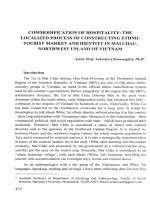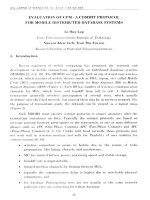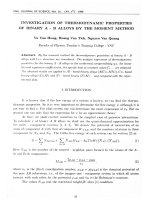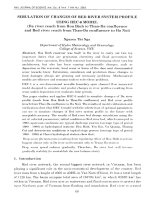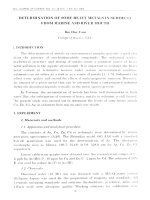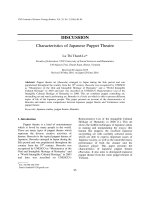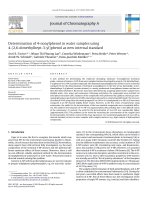DSpace at VNU: Scheduling of virtual screening application on multi-user pilot-agent platform on grid cloud to optimize the stretch
Bạn đang xem bản rút gọn của tài liệu. Xem và tải ngay bản đầy đủ của tài liệu tại đây (443.71 KB, 2 trang )
Scheduling of virtual screening application on multi-user
pilot-agent platform on grid/cloud to optimize the stretch
Bui The Quang & Nguyen
Hong Quang
Emmanuel Medernach
Vincent Breton
Laboratoire de Physique
Corpusculaire
24, avenue des Landais
63171 Aubière, France
+33 (0) 4 73 40 72 72
Laboratoire de Physique
Corpusculaire
24, avenue des Landais
63171 Aubière, France
+33 (0) 4 73 40 72 72
IFI, Equipe MSI; IRD, UMI 209
UMMISCO
42 Ta Quang Buu, Vietnam National
University, Hanoi, Vietnam
+ 84 (0) 4 38696017
ABSTRACT
In this paper, we present our research on the scheduling of
virtual screening platform on grid/cloud which is shared by many
users. We find the scheduling policy to ensure the fairness
between users. We evaluate two policies in existing platform
(FIFO and Round Robin) and two candidate policies from
literature (SPT and LPT) by our simulator. Simulation result
showed that SPT improve performance of scheduling policies in
existing platform.
Categories and Subject Descriptors
D.4.1 [Process Management]: Scheduling, Simulation, Cloud
computing, Grid computing, Large scale biological query, Cloud
Computing for bioinformatics, Grid Computing for
bioinformatics
General Terms
Algorithms, Performance, Experimentation
Keywords
Virtual screening, grid computing, cloud computing, scheduling,
fairness, stretch, online-algorithm, SimGrid.
1. INTRODUCTION
Virtual screening has proven very effective on grid
infrastructures where large scale deployments have led to the
identification of active inhibitors for biological targets of interest
against malaria, SARS or diabetes. Operating a dedicated virtual
screening platform shared by many users on grid resources
requires optimizing the scheduling policy to ensure a certain
fairness between users.
The scheduling of a virtual screening platform can be done at 2
levels; at site level and at platform level. Site scheduling is done
at each site independently; each site is autonomous in its choice
of job scheduling. Platform scheduling is done at group level:
inside a time slot, jobs from many users are allocated. Pilot
agents are sent to sites and act as a container of actual users jobs.
They pick up users jobs from a central queue where the second
stage scheduling is done.
We built a simulator for studying the scheduling of users jobs at
platform level and compared scheduling policies in existing
virtual screening platforms (FIFO, Round Robin) to two
candidate policies (SPT, LPT) from literature [3]. Optimal
criterion used in our research is the stretch, a measure for the
user experience on the platform. For job j with size Wj and flow
time Fj (Flow time is the time an individual job spends in the
platform), the stretch Sj is defined as Fj/Wj. The stretch
represents the user experience on the platform: the larger the
stretch, the lower the satisfaction. We use two indicators, sumstretch (Ssum) and max-stretch (Smax), to evaluate the performance
of scheduling policies. Simulation tests were compared to
experimental results collected using a DIRAC platform [2] on the
European Grid Initiative Biomed virtual organization.
2. SIMULATION OF VIRTUAL
SCREENING PLATFORM ON
GRID/CLOUD
We programmed a simulator with the two-level scheduling of
virtual screening platform, using SimGrid, a toolkit that provides
core functionalities for the simulation of distributed applications
in heterogeneous distributed environments. Figure 1 shows the
structure of simulator with two components: Grid Environment
component and Virtual Screening Platform component
a. Grid environment component
To simulate the grid environment, we built the following
modules in our simulator: Grid Workload, Computing Element
(CE) and Worker Node (WN). Grid Workload module simulates
grid user’s request to CE. This module uses Grid Workload
Archive (GWA) of a real grid as input data to generate user’s
request to CE. The CE node receives and manages grid job in
queues. WN sends job request to CE when it is ready to run jobs.
b. Platform component
The platform component has three modules: Agent Manager,
Task Manager and Docking User Workload.
Copyright is held by author/owner(s)
BCB ’13, September 22 - 25, 2013, Washington, DC, USA
ACM 978-1-4503-2434-2/13/09.
Agent Manager module sends automatically pilot agents to CE.
CE finds available WN and sends pilot jobs to this WN. Pilot
jobs in WN pull docking tasks from Task Manager to execute.
/>ACM-BCB 2013
692
When the computing time of a pilot agent reaches WN maximum
computing time, it is automatically terminated.
3.3 Comparative test of 4 scheduling policies
Docking User Workload module sends user task to Task
Manager. Task Manager receives and manages user task in
queues. Scheduling policy is applied to calculate priority of user
task in queue. When Task Manager receives task request from
pilot agent, user task with highest priority is sent to pilot agent.
In our simulation, we have implemented 4 classical scheduling
policies for the purpose of comparing them: FIFO, SPT, LPT and
Round Robin.
Virtual screening user workloads were generated using a Poisson
random distribution for arrival time of user project and a
geometry distribution for the number of docking tasks in each
project. We generated a dataset with 100 examples of virtual
screening user workloads with 100 to 150 users.
Docking user
Workload
3.3.1 Virtual screening user workload
3.3.2 Simulation result
Grid Environment component
Virtual Screening platform component
Docking tasks
Task
Manager
Agent
Manager
Grid
Workload
Regular grid job
Docking tasks
CE
Regular
Worker
Node
...
.......
grid job
Worker
Node
CE
Regular
Worker
Node
..
grid job
Worker
Node
Figure 1: Simulator structure
3. EXPERIMENTATION
3.1 Grid environment configuration
We used archive data from AuverGrid, a regional
multidisciplinary grid infrastructure in Auvergne (France), as
input data to simulate the configuration for the grid infrastructure
and the grid user workload.
3.2 Validation of simulation
Simulation results were compared to experimental data produced
on the European Grid Infrastructure using a DIRAC platform [2].
A virtual screening project with 1200 docking tasks was
submitted from a DIRAC platform installed at the Institut de la
Francophonie pour l’Informatique in Hanoï. Figure 2 shows the
stretch measured experimentally (diamonds) and simulated
(squares) as a function of x, the number of docking tasks in a
packet. Simulator was run using experimentally measured values
for the latency between pilot agent and grid Storage Element.
Figure 3. Sum-stretch in 100 user workload examples
The results in figure 3 show the sum-stretch for 4 scheduling
policies in 100 examples of virtual screening user workloads.
SPT scheduling policy has the best results, followed by the
Round Robin policy. The worst policies are alternatively FIFO
and LPT.
4. CONCLUSION AND PERSPECTIVE
In this research, we successfully built a simulator for such a
platform using SimGrid [1]. It is used to evaluate scheduling
policies used on existing virtual screening platforms (FIFO and
Round Robin) and two candidate policies (SPT and LPT) from
literature. Simulation result showed that in most cases SPT is
better than FIFO and Round Robin.
We implemented a SPT-scheduler on a DIRAC server in HanoiVietnam. Experimental results confirm that SPT policy reduces
the sum-stretch in this case. Moreover, the technique of grouping
some docking tasks in packet was compared on experimental and
simulated data.
Because Infrastructure as a Service cloud users buy access to
computing resources for a limited time. This is similar with
limited availability of pilot agent on grid. Therefore, we also
propose to implement SPT in deployment of virtual screening
application on cloud environments.
5. REFERENCE
[1] Casanova, H., Legrand, A., and Quinson, M. 2008.
SimGrid: a generic framework for large-scale distributed
experiments. In Proceeding 10th International Conference
Computer Modeling and Simulation. (Mar. 2008). 126-131
Figure 2. Simulation result and DIRAC experience
Both curves display the same behavior: at small x, stretch
increases because of the latency between pilot agents and grid
Storage Elements. At large x, stretch increases because packets
grow linearly with x.
ACM-BCB 2013
[2] van Herwijnen, E. and Gandelman, M. 2003. DIRACdistributed infrastructure with remote agent control. In
Conference for Computing in High-Energy and Nuclear
Physics (CHEP 03).
[3] Legrand, A., Su, A., and Vivien, F. 2006. Minimizing the
stretch when scheduling flows of biological requests. In
Proceedings of the eighteenth annual ACM symposium on
Parallelism in algorithms and architectures. 103-112.
693

